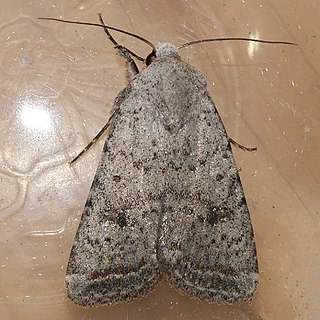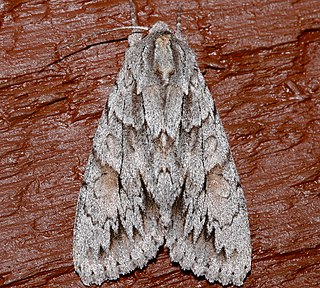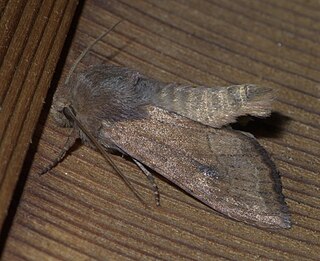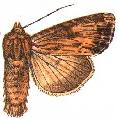Apamea or Apameia is the name of several Hellenistic cities in western Asia, after Apama, the Sogdian wife of Seleucus I Nicator, several of which are also former bishoprics and Catholic titular see.

Apamea sordens, the rustic shoulder-knot or bordered apamea, is a moth of the family Noctuidae. The species was first described by Johann Siegfried Hufnagel in 1766. It is distributed throughout Europe, east across the Palearctic to Central Asia and to China and Japan. It also occurs in North America.
Apamea Myrlea was an ancient city and bishopric on the Sea of Marmara, in Bithynia, Anatolia; its ruins are a few kilometers south of Mudanya, Bursa Province in the Marmara Region of Asian Turkey.

Apamea Cibotus, Apamea ad Maeandrum, Apamea or Apameia was an ancient city in Anatolia founded in the 3rd century BC by Antiochus I Soter, who named it after his mother Apama. It was in Hellenistic Phrygia, but became part of the Roman province of Pisidia. It was near, but on lower ground than, Celaenae (Kelainai).

Apamea or Apameia was a Hellenistic city on the left bank of the Euphrates, opposite the famous city of Zeugma, at the end of a bridge of boats connecting the two, founded by Seleucus I Nicator. The city was rebuilt by Seleucus I. The site, once partially covered by the village of Tilmusa, Şanlıurfa Province, Turkey, is now flooded by the lake formed by the Birecik Dam.

Apamea, on the right bank of the Orontes River, was an ancient Greek and Roman city. It was the capital of Apamene under the Macedonians, became the capital and Metropolitan Archbishopric of late Roman province Syria Secunda, again in the crusader period.

Apamea is a genus of moths in the family Noctuidae first described by Ferdinand Ochsenheimer in 1816.

The Caradrinini are a mid-sized tribe of moths in the family Noctuidae.

Andropolia is a genus of moths of the family Noctuidae.

Andropolia theodori is a moth in the family Noctuidae first described by Augustus Radcliffe Grote in 1878. It is found in the western parts of North America, from British Columbia, south to California.

Andropolia contacta, the Canadian giant, is a moth in the family Noctuidae. The species was first described by Francis Walker in 1856.

Apamea commoda, the southern Quaker, is a moth of the family Noctuidae. The species was first described by Francis Walker in 1857. It is native to North America, where it is distributed from Nova Scotia west across southern Canada to southern British Columbia, north to Alaska and Yukon Territory, and south at least into Manitoba.

Apamea inficita, the lined Quaker is a moth of the family Noctuidae. The species was first described by Francis Walker in 1857. It is native to North America, where it can be found from Newfoundland west to British Columbia, north to the Yukon and the Northwest Territories, and south to Colorado.

Apamea lignicolora, the wood-coloured Quaker or wood-coloured apamea, is a moth of the family Noctuidae. The species was first described by Achille Guenée in 1852. It is native to North America, where it is distributed across much of Canada and the United States.

Apamea plutonia, the dusky Quaker or dusky apamea, is a moth of the family Noctuidae. The species was first described by Augustus Radcliffe Grote in 1883. It is native to northern North America, where it occurs across the boreal regions, with some occurrences from as far south as New Mexico and Pennsylvania.

Andropolia diversilineata is a moth in the family Noctuidae first described by Augustus Radcliffe Grote in 1877. It is found in western North America, from British Columbia south to California.

Pallifera is a genus of air-breathing land slugs, terrestrial pulmonate gastropod mollusks in the family Philomycidae.
Apamea ferrago is a moth belonging to the family Noctuidae. The species was first described by Eduard Friedrich Eversmann in 1837.








